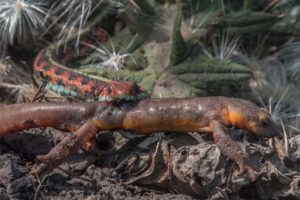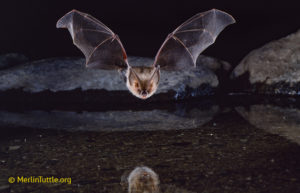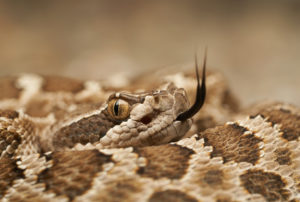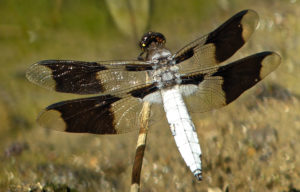It’s a balmy spring morning at Sunol-Ohlone Regional Wilderness, and the fields are a pointillist canvas of purple lupines and pink filaree, yellow buttercups and white popcorn flowers. The buckeyes have leafed out in green-fingered glory, and red-shouldered hawks have returned to the nest of jumbled sticks on the sycamore arching across the creek. Honeybees are nuzzling the California poppies, and songbirds are tweeting, piping, and thrumming in the warming air.
Amid the profusion of seasonal sights and sounds, it’s easy to miss the park’s quieter residents. Roll over a fallen log, and the moist crumbling bark reveals slender salamanders with arms fine as darning needles, translucent termites, and perhaps the sepia and red scales of a sharp-tailed snake hunting slugs. Above the valley, a threatened Alameda whipsnake is racing through stands of chaparral in search of fence lizards. Tucked below that sun-warmed boulder by the stream, ready to snatch its next rodent meal, is the mottled brown coil of a northern Pacific rattlesnake.
The East Bay’s open spaces are home to 17 different snake species. It’s an assemblage of serpent diversity that ranges from vipers to boas living in habitats as different as ponds and rocky outcroppings, animal burrows and open grasslands. And though snakes have been vilified in Western culture since Eve accepted the apple of knowledge, they are a critical part of healthy ecosystems all over the Bay Area—as predators and prey, as species entwined in a complex evolutionary dance with other species, and as creatures of quiet beauty rather than objects of fear.
The descendants of lizards, snakes lost their limbs long ago to pursue an earthier existence. By exchanging bulky legs for a sinuous, muscular body, snakes gained access to a very rich larder. They could enter the burrows and cramped rock pile havens to pursue small animals and insects, while body elongation eventually afforded them the ability to ingest very large prey. And even without limbs, snakes could still swim, climb, and crawl wherever they needed to go.
- Nonvenomous and harmless to people, Pacific gopher snakes are among the largest local snakes; individuals have been recorded up to seven feet long, though four or five feet is more common. Photo by Robert Fletcher.
For the most part, snakes slither about their business unnoticed by human passersby. One study found that an area the size of two football fields could be home to nearly 1,200 insect-eating ring-necked snakes. “It’s hard to appreciate how many places to hide there are. Snakes can tuck themselves underneath a boulder and you’d never see them,” says snake biologist and interpretive naturalist Katie Colbert of the East Bay Regional Park District.
To get a sense of how so many snakes can hide in plain sight, it helps to view the world from their perspective. Pick a spot off the beaten path and stretch out, belly to the ground (though it’s best not to try this in rattlesnake country during spring and summer). From here, the green stems of wild oats transform into the trunks of a swaying forest; the shady crevices between boulders loom into dark slot canyons; and doorways open through the grass, portals into a miniature wonderland of vole trails and fence lizard hideouts.
Take note, too, of the sun that warms your back. Like most reptiles, snakes have no way to generate their own heat, so they need the sun to prime their muscles to move, to speed their digestion, and, in some species, to help gestating young mature before birth. This habit makes areas that absorb solar heat, such as rocky outcroppings, the packed earth of trails, or even the asphalt of roads, good places to spot snakes. On hotter days, snakes will stay under cover in an abandoned ground squirrel burrow or in the shade of a boulder with an arching overhang to keep their internal temperatures tolerable.
Superimposed over that world is a profusion of scents. Just as humans entering a new area take a look around, snakes flick their tongues to get a good whiff of the neighborhood. The forked tip, which helps snakes distinguish the directional source of a smell, ferries odor molecules to a structure at the roof of the mouth called the Jacobson’s organ. Extremely sensitive scent receptors here carry odor information to the brain, helping the snake identify nearby prey, mates, or enemies.
In addition to this standard equipment, pit vipers such as the local northern Pacific rattlesnake (Crotalus oreganus oreganus) possess organs on their snouts that function as heat detectors for warm-blooded prey. Once it finds its quarry, the snake strikes and injects its prey with a shot of venom from hollow fangs, and then backs off. The corrosive cocktail destroys platelets and causes internal bleeding, helping to digest prey from the inside out by dissolving tissue. That can take a while, but a pit viper can afford to wait: The snake’s heat-sensing organs help it track down its prey once the venom has done its work.
Colbert, who has been studying the rattlesnakes at Sunol for eight years, has tracked the comings and goings of about a dozen rattlesnakes there with the help of implanted radio transmitters. Her observations provide an intimate view of the life of this feared but rather peaceable serpent.
“In all the years I’ve been out here trapping snakes, I don’t remember being rattled at once, except when I had to take the snake in to get a new transmitter,” says naturalist Colbert. Far from looking for trouble, rattlers make a living being inconspicuous. Though their distinctive pattern of oval blotches may stand out in the confines of a terrarium, it can easily disappear against corrugated soils or the dappled shade of a grassy hollow.

- A northern Pacific rattlesnake in defensive posture. Photo by Dan Suzio.
Relatively large and heavy-bodied, rattlesnakes are ambush hunters that wait for prey to come to them. Living in habitats ranging from open grassland to chaparral to riparian streamsides, northern Pacific rattlesnakes are versatile predators. As juveniles, they start out eating small lizards but as adults shift their diet to small mammals such as mice and young ground squirrels. Mature rattlers normally reach lengths of three to five feet and can live for more than 20 years in captivity. Colbert often spots rattlesnakes in hunting mode, neck held in the S-curve of an ambush position across flattened body coils. She observed one female snake holding this pose in the same spot for three consecutive days.
- Gopher snakes sometimes make the most of their resemblance to rattlers by flattening their heads into a viper-like triangular shape and even vibrating their rattle-less tails against dry grass. Such accomplished mimicry can get them in trouble with scared and aggressive humans. Look for the gopher snake’s pointed tail and glossy skin to tell the difference. Photo by Ron Wolf.
As unobtrusive as rattlesnakes generally are in the wild, their paths do occasionally cross those of people. The park district regularly gets reports of rattlers at picnic tables or other developed areas. In these cases, it’s standard practice to capture and relocate the animals to avert potential confrontations.
Colbert is always careful not to release a snake far from its site of capture. Research indicates that rattlesnakes moved into unfamiliar territory are less likely to survive. Transplants are forced to expend precious energy exploring new ground and may have difficulty finding a safe place to hibernate through winter.
Rattlers and many other snakes have home ranges— areas they are familiar with but do not actively defend against other snakes. Just as humans get to know the location of neighborhood supermarkets and banks, snakes note the positions of animal burrows, rock crevices, bushes, and other landmarks. This internal map helps them find what they need to survive: food, shelter from the hot sun, and a protected spot to hibernate during winter. One of Colbert’s tagged snakes, for example, frequented a length of the valley floor that can be covered in a 10-minute stroll. Colbert saw him over and over again in the area, on the slopes and in the rocks that line the water, even swimming across the stream itself. She has also tracked snakes to the same winter hibernaculum two and three years in a row.
Rattlesnakes may go through life packing some potent venoms, but they are not immune to being eaten. “People mostly think of them as predators, but they’re just as much prey,” Colbert says. She recalls happening upon a dramatic encounter between one of her tagged snakes and a bobcat. The bobcat swatted at the snake and jumped back, while the rattlesnake struck and fell back. “Eventually they were both in the air at the same time. It was just amazing,” Colbert says. “I thought the bobcat was the silliest animal to try this. But the rattler didn’t make it.”
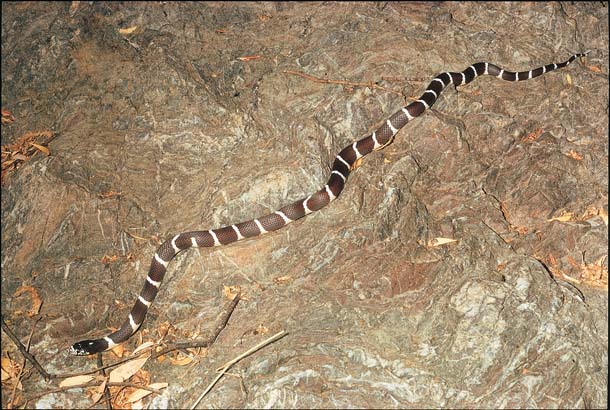
- The California kingsnake is a powerful constrictor that is resistant to rattlesnake venom and will attack and eat rattlesnakes. Photo by Edward S. Ross.
Nor will a rattlesnake’s fangs keep it safe from its reptilian brethren. The California kingsnake (Lampropeltis getula californiae), named for its ability to kill and eat other serpents, is renowned for its imperviousness to rattler venom. Colbert recalls an instance that drove this point home. She spotted a California kingsnake in the seemingly foolish act of swallowing a juvenile rattler tail- instead of headfirst. As the kingsnake engulfed its midsection, the rattlesnake repeatedly struck and bit its captor. But because the blood of kingsnakes contains proteins that are extremely effective at neutralizing rattlesnake venom, the kingsnake prevailed.
One of the most commonly seen snakes in the wild is the common garter snake (Thamnophis sirtalis), a serpent that is not venomous itself, but has evolved an impressive imperviousness to a toxin in its prey. These slender, colorfully striped snakes, the most widespread in North America, can be found in habitats ranging from woodlands to city lots, as long as there is water nearby. Specialists at snapping up aquatic prey, they have been known to gulp down everything from polliwogs to juvenile trout. In the East Bay, common garter snakes specialize in eating amphibians—even some that are extremely poisonous.
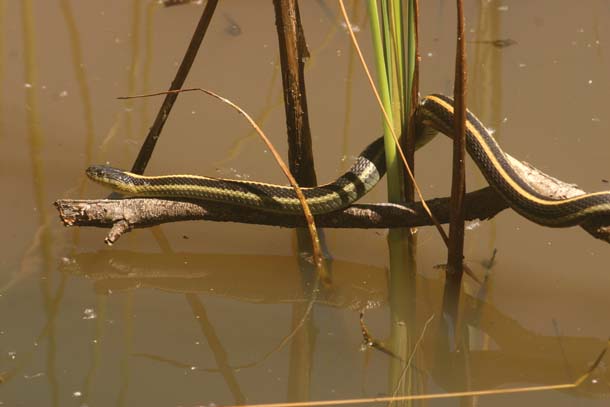
- Garter snakes, common pond predators, have evolved resistance to the potent neurotoxin found in California and rough-skinned newts, two of their favorite prey species. Photo by Sarah Bettelheim.
Both the rough-skinned newt (Taricha granulosa) and its close relative the California newt (Taricha torosa) stash a potent poison called tetrodotoxin (TTX) in their rubbery brown skins. Lab tests indicate that a single eight-inch newt contains enough TTX to kill eleven 160-pound people.
TTX, the same neurotoxin carried by pufferfish and the blue-ringed octopus, interferes with the transmission of electrical signals along muscles and nerves. It binds to and blocks the sodium channels that propagate electrical signals, paralyzing and then suffocating victims.
Soft-bodied and slow, newts rely on TTX to fend off would-be predators. They have few enemies, and their numbers can swell to the hundreds in a single two-acre pond. This abundance may have spurred garter snakes to take the evolutionary road to TTX resistance.
Just this year, Charles Hanifin of Stanford’s Hopkins Marine Station and colleagues provided a detailed snapshot of the relationship. The researchers collected both newts and garter snakes from Vancouver Island to Southern California, testing the newts for toxicity and the snakes for TTX resistance. In some places, both snake resistance and newt toxicity were closely matched, as expected. But in several places—central Oregon, the Sierra Nevada, and the Bay Area—the snakes have clearly edged ahead. These newts were among the most toxic found in the scientists’ survey, but the snakes were so resistant, they could eat even the most TTX-laden animals and survive. “These snakes have escaped from the arms race; they have evolved to the point where they have broken the reciprocal bonds with the newts,” Hanifin says.
But resistance has a cost: It appears to make snakes more sluggish, and therefore more vulnerable to predation. “The faster snakes may gain an advantage,” Hanifin says, “and over time we may see evolution driving resistance down until the snakes start coevolving with the newts again.”
Those snakes that can ingest toxic newts may retain a different advantage. Research by Becky Williams, now a doctoral student at UC Berkeley, indicates that snakes retain a lethal dose of TTX in their bodies for weeks after a newt meal. Provided they survive, predators such as gray foxes that ingest temporarily toxic snakes might avoid garter snakes ever afterward.
Other snakes use a different method to avoid predation: mimicry. When threatened, a Pacific gopher snake (Pituophis catenifer catenifer) will flatten its head and broaden its jaws into a triangle shape while shaking its tail against grass or leaves to make a rattling noise (see photo, above). To make the act even more realistic, it may coil up its body and even lunge forward. With its suit of mottled brown and yellow scales, a gopher snake looks for all the world like a rattler about to bite. The performance is so convincing that even Colbert looks twice to ensure her safety. The details to notice are the gopher snake’s glossy skin and pointed tail, which signal you have nothing to fear.
The California mountain kingsnake (Lampropeltis zonata) may be yet another impostor. Especially secretive even among snakes, this species hides in rocky areas of moister habitats such as riparian glades, conifer forests, and oak woodlands. Its bold bands of red, alternating with thinner rings of black and white, give it an uncomfortable resemblance to the deadly coral snake.
The likeness is so strong that Mitchell Mulks, a graduate student at the University of California, Santa Cruz, speculates that it helps California mountain kingsnakes ward off predators that mistake it for a venomous snake. Yet coral snakes live in the desert Southwest. They are not now, and never have been, found in California.
Mulks contends, however, that warning colors inspire automatic fear in birds and other animals with color vision, so that actual experience with a coral snake isn’t necessary to confer protection. The California mountain kingsnake, Mulks says, “is cheating the system, taking advantage of the birds.”
Other scientists have proposed that the California mountain kingsnake employs its vivid colors in a very different way—as a lure. Like several other local serpents, California mountain kingsnakes can climb trees and bushes to raid bird nests. The trick is locating such a well-camouflaged target. In Southern California, researchers observed one snake draping itself conspicuously beneath a tree frequented by a pair of flycatchers. The snake remained motionless until the birds attacked. It then inched up the oak, stopping to explore the point in the tree where the parents upped their aggression. The actions of the parent birds led the snake right to their nest.
An equally elegant, but much rarer, local snake is the Alameda whipsnake (Masticophis lateralis euryxanthus). With an olive-to-black body that may be five feet long but no thicker than two fingers, and accented by a pair of bright orange “racing stripes,” it roams the rocky scrub of chaparral as well as open grassland chasing down fence lizards and frogs, and even other snakes. This fast-moving and extremely athletic snake, which hunts by sight, has even been reported by birders to have devoured a goldfinch in the branches of a tree on Mount Diablo.
The Alameda whipsnake is also the only threatened snake species in the East Bay. Much of its preferred habitat has been swallowed up by housing and urban development. “We’ve encroached on a lot of the good remaining scrub. Many areas are now invaded with eucalyptus groves, French broom that is too dense to allow the snakes to see their prey, and other nonnative plants,” says Karen Swaim, a herpetologist and environmental consultant. Swaim, who conducted a tracking study of whipsnakes in Tilden Park some 20 years ago, says access to diverse habitats is just as critical for the species. “Though scrub is where they hang out the most, they move between sunny slopes, across shady drainages, and even into oak-bay woodland,” she says. The Alameda whipsnake is now an important factor in local land management decisions, with more than 154,000 acres throughout much of the East Bay designated as critical habitat for the species.
Whether you reside next door to a regional park or up the street from a vacant lot, snakes probably don’t live too far away. The idea of neighbors that don’t blink and have double-hinged jaws might be a bit unnerving. But these legless locals keep the vermin at bay, feed the hawks overhead, and occasionally offer up a shed skin for show-and-tell in school classrooms. Alien though they may appear, snakes are very good neighbors.
The East Bay Regional Park District offers two color brochures, “Living with Snakes” and “Common Snakes of the East Bay,” both available at visitor centers or by phone; call (510) 635-0135.

.jpg)

